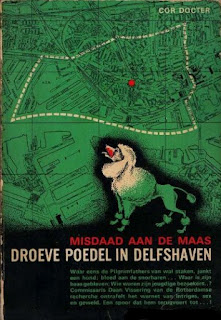"Everything has a beginning and an end. Life is just a cycle of starts and stops. There are ends we don't desire, but they're inevitable, we have to face them. It's what being human is all about."- Jet Black (Cowboy Bebop)
First of
all, I want to beg your forgiveness for indulging, three times in the span of
four weeks, in those pesky, untranslated detective stories, but Cor Docter has
captured my fascination and this review will round out the trilogy of books
featuring Commissioner Daan Vissering – a kind and intelligent policeman. Even
more good news, I have in my possession a little known, disregarded locked room
mystery from the 1930s and it's up next, but for the time being, bear with me
as I babble about one more of these books.
Now that
I have read all three volumes in this series, I understand what Docter set-out
to do with them and it's an effort that I very much appreciate: Droeve poedel in Delfshaven (Melancholic Poodle in Delfshaven, 1970) was a
Grand Whodunit in the tradition of Agatha Christie, Koude vrouw in Kralingen
(Cold Woman in Kralingen, 1970) re-opened John Dickson Carr's beloved
Locked Room Mystery for business and Rein geheim op rijksweg 13 (Pure
Secrecy on Highway 13, 1971) mimics the signature trademark of Ellery Queen, the Dying Message. However, as mentioned before in these reviews, they're
hardly throwbacks, but more of an overhaul that resettles them in the modern world
of the early 1970s – populated with mostly working and lower class people who are
caught in the meshes of intrigue.
Highway
13 was one of the busiest highways of the country and there’s always someone
traveling down that road, no matter what hour of the day it is, which makes the
plan of two petty thieves, Sander Wils and Peter Ruivenvoorde, all the more audacious.
They want to strip a delivery van, abandoned on the emergency lane, of its valuable
parts, but what they find in the back of the car throws a spoke in their wheels:
slumped between scattered protest signs there’s the body of a man, hit over the
head, and one hand resting in an open canister of red paint. On the inside of
the van the dying man had scrawled "16NK2-" and it’s definitely a sign that
Vissering's plan for Charles Dickens-style Christmas is in jeopardy. The scene
of the crime also provided me with the post title, because the stranded van,
containing the dead man's message, reminded me of a bottle that had just
drifted on shore after an exhausting journey – with the lights and sound of passing
cars standing in for the murmur of the sea and a cone of light from a nearby lighthouse. I thought it was an interesting image.
The thorough investigation of Vissering and his men uncover a number
of plot threads that run in various directions, but still appear to be connected to
the body in the van. There are the signs protesting the pollution of the air
with garish slogans and this turns up a second death, a suicide of the wife of
one of the members of a protest group, and a glass of diluted bleach is one of the key clues
in this little side puzzle. You need a piece of trivial, household
knowledge from this particular period to completely solve it, but it's actually
quite clever and could've easily been used to give a satisfying explanation to a
locked room scenario that turns out to be nothing more than a simple suicide. Docter
only had to let Ella van der Klup jump from an open window inside her locked
apartment, instead from the gallery outside, with her husband snoozing in the
other room.
Vissering
also has to tangle with "Boere-Bram," a Lombard, of sorts, of scrap metal and
junk, who has a link with the murdered man, who turns out to be the straight up
brother of a convicted criminal who has stashed away his loot, hundred fifty
thousand guilders, as a nest egg for when he gets out – which is sooner than
everyone expected! There’s also an old, mysterious man, named Siem Bijl,
bumping into Vissering wherever the investigation takes him and a German
bayonet is also thrust into the case. As to be expected by now, Docter pulls
off a conclusion as classical as it's satisfying. It's like the back blurb
said, "This time no Carter Dickson effects, but 'keys' that are reminiscent of
the best plots of Ellery Queen, Peter Quentin (sic) or the immortal
Dorothy Sayers.”
Lastly, I
should mention that Pure Secrecy is also very strong in its commentary on
modern society and its condemnation of the annexation of Overschie by Rotterdam
– polluted and defaced in the process. Highway 13 was carved right through it and "housing barracks" (i.e. flats) tore the old atmosphere and community asunder. Docter
already warned and apologized in his introduction that his description of the
then present-day Overschie would be a very colored one – because the old
Overschie was very dear to his heart.
Docter's detective
novels may be steeped in old traditions, but he made a valiant effort at updating
them to modern times and, more often than not, succeeded in doing so and this earned
himself a place among the ranks of post-GAD writers who proved the old adage
that a classic never goes out of style.















